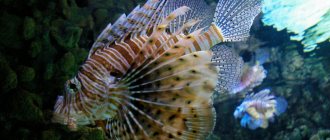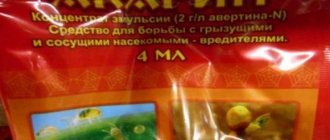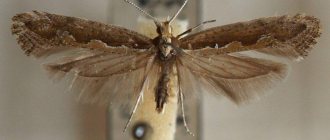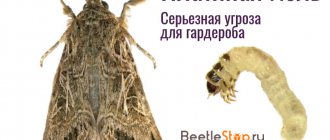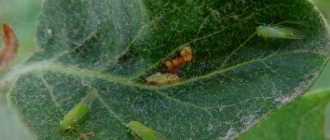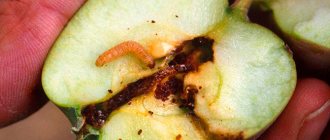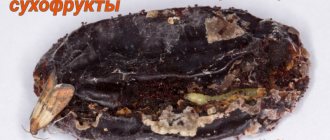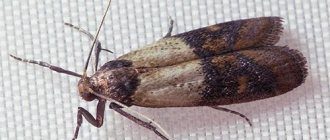Varieties of midges
Households do not immediately detect midges. Initially, the pests are in the ground. They appear on the surface after watering. A little time passes, and a swarm of insects circles above the flower. The spectacle is horrifying, and something needs to be done about it. Midges do not sting or bite people. However, its presence can not only destroy the flower, but also harm human health, causing an allergic reaction and respiratory disease.
What types of midges are found on indoor flowers? The list is impressive:
| Kinds | Description |
| Drosophila | Small flies of a yellowish tint with light wings. The eyes are red. Females are larger than males. They have a pointed abdomen. They eat spoiled vegetables and fruits. They prefer to live in the kitchen and in the trash can. But they can also live in a flower pot. They are happy there with warmth, organic fertilizing, high humidity and rotten leaves. |
| Whiteflies (aleroidids) | In appearance they resemble butterflies. Small, white. They choose a place on the back of the foliage. They eat juice. The eggs laid quickly transform into larvae. When there are many of them, the flowers become whitish. Just touch the pot and a swarm of whiteflies will rise into the air. Most often they settle on begonias, orchids and fuchsias. |
| Sciarides | They are also called fungus gnats. The body is narrow, the head is round, they are grayish and black. They live in moist soil, where the process of decay occurs. Translucent larvae up to 10 mm long are laid in the ground. |
| Thrips | There are black, gray and brown midges. Quite mobile individuals. Adults constantly move from flower to flower, laying eggs inside the leaf. After hatching, the larvae immediately begin to feed on the sap, causing harm to the flower. How do you know when thrips are present? The foliage is covered with streak-like spots and white larvae. Dark midges fly around the crown. |
| Podura (springtails) | A distinctive feature of pests is that they cannot fly, they only jump. Present in every pot. Populations are small, so they are difficult to notice. Springtails are white in color and resemble caterpillars in appearance. They give themselves away when their number becomes large. They love dampness and feed on organic ingredients. |
| Shields | A parasite that reproduces at tremendous speed. Prefers to settle on flowers with hard and smooth leaves. The scale insect cannot be ignored. The leaves are covered with convex or flat oval-shaped shields and a light brown hue. |
| Spider mite (red spider) | The most common type of pest. The main sign of the appearance of a parasite is the presence of a thin and transparent cobweb on the flower. Small punctures may also appear on the leaves. They reproduce well in a dry room that is rarely ventilated and not moistened. The appearance of spider mites causes the leaves to turn pale or gray, dry out and fall off. |
| Leaf aphid | Does nasty things all year long. The sizes are miniature, but aphids are easy to spot. The color is very diverse: red, black, yellow, brown, green. Loves soft and delicate foliage, young shoots, buds. It poses a great danger to weakened flowers. Their growth slows down and they quickly wither away. |
| Mealybug | Reminds me of tiny pieces of cotton wool. It is difficult to notice, since it prefers to hide in the axils of the leaves. It is dangerous for all flowers, especially when the number of mealybugs reaches huge numbers. |
Why are they dangerous?
Like many indoor insects, flower midges are not dangerous to humans. Midges will not bite or transmit dangerous infections. However, in addition to the unpleasant sensations from such a neighborhood, small parasites cause moral damage by destroying flower plants that purify the air and create comfort in the house.
Small gray-black flies lay large numbers of eggs in moist soil. They hatch into voracious white worms that eat the roots of the flowers. The plant begins to wither. Young plantings with an undeveloped root system die faster. You can save your “green friend” if you come to the rescue in time, before all the roots of the flower are affected. It is necessary to transplant the plant into a pot with high-quality soil, first remove the oviposition.
The presence of midges is not a reason for despair. Perhaps the parasites did not have time to settle in the pot. It’s easy to verify this: you need to dig up the ground next to the plant. No larvae found? This means that there remains a real chance of saving the flower. After all, fighting insects is much easier than fighting their “children.”
Causes of parasites
Experts believe that the main reason for the appearance of midges is improper care of indoor flowers. The main mistakes that are made are:
- The appearance of insects in the house with a new flower. Before installing a new acquisition next to the “old-timers”, it is necessary to quarantine it. Time will tell what is in the soil. If pests and diseases are present, they will manifest themselves within two weeks. It is worth taking certain safety measures. You need to think about how to get rid of parasites. Only after complete cleaning can the pot be placed on a common windowsill.
- Application of organic fertilizers. Some people prefer to feed their pets with humus, granulated sugar, leftover tea and coffee, and yeast. On the one hand, the flowers are provided with nutritional components, on the other hand, the process of decay of the organic composition begins, which becomes an ideal environment for the appearance and reproduction of pests.
- Waterlogging of the soil. Watering plants too frequently and abundantly is not recommended. Especially if the pot does not have good drainage. This also applies to greenhouses for growing flowers from seeds. Do not water the soil abundantly in winter, even if the room is too hot.
- Application of contaminated soil. Pests can be found everywhere, so there is a possibility of their presence in any soil. Before planting a sprout in the soil mixture, it must be disinfected.
Midges can be caused by open windows. It is impossible to completely eliminate the appearance of pests, no matter how hard you try, so it is necessary to take preventive measures and prevent significant reproduction of insects.
Why do flowers get midges?
Florists explain why flowers harbor midges. If you understand this well, then it’s easier to get rid of them.
The flower midge is bred for the following reasons::
- Dampness. If the soil is watered frequently and there is no good drainage, the liquid stagnates and the substrate sours. For small pests, these are very comfortable conditions for reproduction.
- Open windows. If there are no mosquito nets on the windows, insects can easily attack indoor plants.
- Contaminated soil. Soil taken from the garden or purchased from an unverified supplier often contains parasite larvae. To prevent infection from occurring, it is useful to calcine the soil or water it with a manganese solution.
When using dried tea to fertilize the soil, the likelihood of flower midges greatly increases. It is recommended to feed them only with special fertilizers. It’s worth asking florists how to do this.
In order to prevent infection, they recommend treating house plants with a weak solution of an insecticide (Actellik, Kinmiks) from time to time.
Signs of infection
Midges are too small to immediately detect their presence. They hide under leaves and in moist soil. Only when they reach a huge number do they reveal themselves. In most cases, the larvae are found in the ground, in the area of the root system, so it is quite difficult to see them. Despite the “secrecy”, there are some signs that allow you to accurately determine the presence of parasites. These include:
- the occurrence of diseases;
- the appearance of a whitish coating on the leaves and stems;
- the substrate or soil becomes crumbly;
- the ground “fades” a little.
The most vulnerable species are considered to be:
- fuchsia;
- azalea;
- ficus;
- aloe;
- epiphytic cacti;
- gerberas;
- violets;
- begonias.
What are the best remedies for getting rid of midges?
To defeat the scourge, you can use several methods. They differ in effectiveness, consequences, composition, order of application, and timing of implementation. How to choose the right product? Much depends on the specific situation. Let's look at the most common methods of pest control:
- Use of chemistry. Efficiency at altitude, however, has a negative impact not only on midges, but also on people. Before you start using the drug, you must carefully study the attached instructions.
- Mechanical method. Considered safe. Chemicals are completely excluded. Application after insects have laid eggs does not lead to a positive result.
- Drying the top ball of soil. Watering is temporarily stopped until the soil becomes dry at a depth of 3 centimeters. Dry soil is destructive for midges and their larvae.
- Removing parasites using a vacuum cleaner. It is enough to remove the brush from the equipment and, at low speed, treat the window sill, pot, leaves, stems, and the top ball of the earth. At the end of the manipulations, the bag is removed from the vacuum cleaner and taken away from the house. Afterwards, the flower is placed in a bathtub and subjected to sprinkling using insecticides in reduced concentrations.
- Soaking. A disinfectant is added to the settled water. We are talking about laundry soap, a weak solution of manganese, and ammonia. Most often, laundry soap is used, which is grated, diluted in warm water, and applied to the plant and soil using a spray bottle.
- Traps. Where to buy devices? You can visit a specialized retail outlet. The average price of any trap is reasonable. There is an option to save money and make the design yourself. The method will get rid of pests for several days. Take beige or yellow cardboard and honey. Thin strips are made of cardboard and laid out near the pots. Honey must be spread in a thin layer. Other ingredients are also suitable, such as compote, sweet wine, apple cider vinegar. You can use saucers instead of cardboard.
- Soil replacement. An effective way to get rid of parasites. You can replace the soil completely or remove the ball to a depth of 3–5 centimeters. Improvements will appear in a couple of days. When replacing the soil, you can immediately disinfect the root system. It is advisable to pour boiling water over the pot itself and the drainage. It is recommended to temporarily quarantine the transplanted flower separately from other plants for two weeks.
Chemicals
How to remove flies from indoor flowers when traditional methods have been used but there are no results? It's time to take on the “heavy artillery.” First you need to think about tactics. The easiest way is to treat the area next to the flower pot with an aerosol can. Experienced flower growers advise choosing trusted brands. Such as "Raptor" or "Dichlorvos".
Before starting the procedure, you need to carefully read the instructions and prepare the room: remove things, food, “evacuate” family members and pets. Spray the surface on which the flower pots stood and the area next to them. After treatment, it is necessary to ventilate the room and carry out wet cleaning.
Midge larvae and eggs are removed with insecticidal agents, such as:
- Agravertine;
- Fitoverm;
- Karbofos;
- Actellik.
The drug is diluted with water, according to the manufacturer’s recommendations, and the soil in the flowers is washed with it. Flower growers advise not to water the soil for several days so that the insecticide does not leave before the prescribed time.
Folk remedies for pests
If midges are detected at the initial stages, and have not yet had time to multiply, then folk remedies will help in the fight against them. They are completely safe. Can be used where small children and pets live. The most common, effective and popular means are considered to be:
- Garlic. Place it in a flower pot or lay out the cut cloves on the surface of the soil. You can spray the flower with the infusion periodically.
- Potassium permanganate. A weak, pale pink solution is made. The liquid is used for watering and spraying.
- Ash. Insects don't treat her well. It is enough to scatter wood ash in a thin layer over the soil mixture.
- Matches. The good old method of getting rid of pests. Four to five matches are placed in the pot with the sulfur heads down. Then pour warm water over the container. You need to change matches every day.
- Citrus. You can take orange peels and put them in a flower container.
- Dill. The branches are simply placed in the area of the root system.
- Tobacco. Leaves are treated with tincture.
How to get rid
Two or three white flies flying around the apartment can be called random. Still, you need to inspect the potting soil - are there any traces of larvae? If the alarm turns out to be false, then it is easy to deal with dipteran parasites on your own. However, the appearance of a large number of insects will require radical measures to fight for the life of green pets.
How to get rid of flower flies? First, you should isolate the affected flowers from healthy ones. Only after this can plants be processed and treated using traditional methods or using chemicals.
Prevention
To avoid the appearance of insects in the house, it is necessary to properly care for plants. This will be helped by preventive measures that do not harm the environment and minimize the possibility of parasites. What is meant by the word “prevention”? This is a list of simple steps:
- Control of air and soil humidity. It is necessary to create comfortable living conditions for flowers. If the room humidity is high, it must be dried; if it is excessively dry, it must be moistened. Regular ventilation is mandatory.
- Moderate watering. Excessive watering should be completely avoided. Waterlogging of the soil negatively affects the growth and development of plants and leads to accelerated reproduction of pests.
- High-quality drainage. Necessary in order to avoid stagnation of water in the root system area.
- Loosening the soil. We are talking about an upper ball with a depth of 3 to 5 centimeters. In order for a plant to grow and develop well, the roots need access to oxygen. Open air is harmful to the larvae.
- Quarantine. It is advisable to exhibit “newcomers” in a separate room for a period of 30 days. If pests are present, they can be identified and measures taken to destroy them.
- Plant purity. You need to constantly monitor the appearance, remove fallen leaves from the stem and soil to prevent them from rotting.
- Regular visual inspections of flowers to identify midges.
- Steaming the soil with boiling water and using a disinfecting manganese solution.
- Adding marble chips, ash or coarse sand to the soil.
It is better to prevent pests from appearing than to fight them later.
Rating of high-quality liquid insecticides against midges and in tablet form
Aktara
This substance will be an excellent assistant in the fight against winged creatures that have settled in flower tubs and pots. The product belongs to the category of neonicotinoids. It has a negative effect on the nerve receptors of insects, which leads to their rapid extermination. The substance dissolves in water and is applied under the root, or on the leaves and trunk by spraying. The first option is preferable, as it is characterized by pronounced systemic activity. Works well against larvae in the ground, eliminating the risk of a new batch of winged creatures appearing. After application, the substance remains active for 14 days. To avoid mistakes when choosing, it should be noted that the product is not selective. The first result can be seen a few hours after treatment. The composition is not classified as toxic, which eliminates the risk of damage to the plant roots.
The average price of a new product is 4,424 rubles.
Aktara
Advantages:
- efficiency (regardless of application conditions);
- high rate of inhibition of insect feeding;
- a systemic effect is observed when applied to the soil;
- when spraying, a translaminar effect is observed;
- wide scope of application;
- long lasting effect;
- harmless to leaves and roots.
Flaws:
- high price.
Fufanon Nova
This substance is used as a remedy for the appearance of midges. Allows you to process many crops, and not just indoor ones. To avoid mistakes when choosing, it should be noted that the manufacturer recommends processing indoors in the absence of animals and children nearby. Also, after completing the manipulations, it is recommended to thoroughly wash your hands, take a shower and change clothes. It would be a good idea to use a respirator. The container should be stored separately, in a dark and dry place. The substance should not be mixed with other pesticides. During the preparation process, it is necessary to strictly adhere to the instructions proposed by the manufacturer in order to avoid negative consequences regarding health.
Cost – 1350 rub.
Fufanon Nova
Advantages:
- convenient form factor;
- wide scope of application;
- efficiency;
- the substance is harmless to plants, subject to dosage;
- long lasting effect.
Flaws:
- processing is carried out in special clothing and in strict accordance with the instructions.
Fitoverm
This insecticide belongs to the biological category. It can be used not only to combat indoor and flower midges, but also other harmful insects. It should be noted that the composition does not have a cumulative effect and does not accumulate in the fruits, inflorescences, foliage and soil of the plant. Capable of suppressing certain groups of insects up to 100%. In addition, it is not classified as toxic. The dosage is indicated by the manufacturer on the packaging, and it must be followed. It is recommended to carry out the treatment away from animals and children, in a well-ventilated area. You should also take a shower and change clothes immediately upon completion of the manipulations. The container should be stored in a dry and cool place, away from children. The product should not be mixed with other pesticides.
How much does the container cost? The purchase will cost 160 rubles.
Fitoverm
Advantages:
- long lasting effect;
- 100% elimination of midges;
- affordable price;
- ease of use;
- the composition is non-toxic.
Flaws:
- not identified.
Inta-vir
This drug will help get rid of not only midges, but also many other winged pests that plague apartment residents. One tablet is enough to make 10 liters of solution. It should be noted that spraying should begin immediately after preparation of the substance is completed. All leaves should be evenly moistened, as should the trunk of the plants. It is based on the use of cypermethrin. Based on the manufacturer’s statement, the tablet effectively fights 52 types of pests. Once opened, the product should be used as it cannot be stored further. New packaging should be kept out of the reach of children.
Cost – 86 rubles.
Inta-vir
Advantages:
- long lasting effect;
- ease of use;
- does not harm the plant;
- 100% elimination of midges;
- prolonged effect.
Flaws:
- not identified.
Top best granular insecticides for midges
Bazudin
This drug is based on the use of diazinon. Supplied in the form of granules that dissolve well in water at room temperature. It is noted that it is highly effective against soil-dwelling insects, as well as their larvae. It will also allow you to get rid of garden ants and wireworms 100%. A review of reviews indicates a high impact rate. The first result can be observed a few hours after application. It is also noted that it has a long-lasting effect. The manufacturer recommends applying 15 g of the substance per 10 m2 of area. It can also be used as a prophylactic agent. To do this, the substance is introduced during the process of plant transplantation.
Average price – 70 rubles.
Bazudin
Advantages:
- long lasting effect;
- wide scope of application;
- granules can be either dissolved in water (for subsequent spraying) or applied in their original form;
- affordable price;
- speed of onset of effect.
Flaws:
- not identified.
Grom-2
This highly effective drug belongs to the complex category. Designed to combat ants and soil midges. The effectiveness of the substance remains regardless of the conditions of use. Eliminates not only visible insects, but also larvae that hide in the soil. It is supplied ready-made and does not need to be dissolved. Apply in an even layer to the soil, greenhouses or beds. It is used for both fruit and berry and flower crops. Should be stored in a cool place, out of reach of children and pets. Processing can be carried out in any weather, without temperature restrictions.
How much does the packaging cost? The purchase will cost 16 rubles.
Grom-2
Advantages:
- wide scope of application;
- ease of use;
- functionality;
- practicality;
- high level of efficiency;
- can be purchased through the online store;
- can be used not only for treating indoor plants;
- affordable price.
Flaws:
- not identified.
Fly eater
This highly effective product is designed to combat soil pests. Suitable for processing not only flower crops, but also vegetables and fruits. It fights well against both adults and larvae. After treatment, it will take 48 hours to completely get rid of pests. It should be noted that the product has a protective effect, thereby eliminating the risk of insects in the near future. Does not accumulate in the soil and dissolves quickly. It is recommended to treat the color once a season for maximum effectiveness. Does not have a negative effect on the plant and microorganisms living in the soil.
Cost – 13 rubles.
Fly eater
Advantages:
- form factor;
- wide scope of application;
- versatility;
- effectiveness;
- sold at any specialized retail outlet;
- numerous positive reviews;
- ease of use;
- 100% destruction of insects.
Flaws:
- not identified.
Special pesticides
You can visit your local garden store to purchase special pesticides (make sure they are labeled for home use) that you can spray on the problem area. Flower petals and leaves may show signs of damage from pesticides, but they usually do not kill the plant itself.
Or solve the problem with the help of insecticides in the form of tablets or granules: Fitoverm, Aktara, Tanrek, Fly eater. For the most part, they work as a fertilizer and help fight midges - 2 in 1. Distribute them according to the instructions in quantities depending on the size of the pot and the volume of soil. Water as usual and wait for the result.
Remedy for midges in indoor flowers
Rating of the best aerosol repellents for midges
Raptor
This aerosol is based on the use of tetramethrin and cypermethrin. Insects can appear not only in a private house, but also in an apartment. Midges are no exception. No one would want to live next door to them. The midge living in the pot lays eggs in the soil of the pot. The Raptor will do an excellent job with the flying and underground inhabitants of the flower tub. This product is also perfect for fighting moths, mosquitoes, fleas, ants and even cockroaches. The brand needs no introduction and is in high demand among European consumers. Supplied in a convenient 275 ml bottle. Despite the fact that the composition is considered safe for humans, the can should be kept out of the reach of children. During storage, it is recommended to give preference to a cool and dark place.
How much does a can cost? The purchase will cost 514 rubles.
Raptor aerosol
Advantages:
- ease of use;
- economical consumption;
- speed of onset of effect;
- wide scope of application;
- value for money;
- functionality;
- patented technology.
Flaws:
- not identified.
Bona Forte
This drug is characterized by an unusual composition and a high efficiency rate. It is based on the use of Dalmatian chamomile inflorescences. An excellent solution in the fight against crawling and flying harmful insects. There is a high speed of impact on midges, without causing addiction. Designed for treating plants in the garden and at home. During the processing process, the risk of the substance getting on the inflorescences and young buds should be eliminated. Such manipulations are carried out in the shade, eliminating the risk of direct sunlight hitting the treated areas of the plant. Available in a 0.5 liter bottle with a sprayer. Subsequent storage should be away from children, in a dark and cool place.
How much does a can cost? The purchase will cost 255 rubles.
Bona Forte
Advantages:
- wide scope of application;
- lightning-fast results;
- convenient form factor;
- does not affect the well-being of the plant;
- can be used throughout the year.
Flaws:
- not identified.
Dichlorvos Neo
This insecticide is available in aerosol form. The composition contains stabilizers, fragrances, cypermethrin, piperonyl butoxide, preservatives, ethyl alcohol and permethrin. The substance belongs to class 3 (moderate) hazardous substances. Effectively fights not only flower midges, but also flies, fleas, ants, bedbugs and even cockroaches. Designed for treating residential premises. Before use, shake the can thoroughly. Sprayed at a distance of 20 cm from the plant. In this case, the temperature regime should be at least +10°C. Such manipulations should be carried out in a well-ventilated area, excluding observers such as animals and children.
Average price – 90 rubles.
Dichlorvos Neo
Advantages:
- wide scope of application;
- affordable price;
- 100% elimination of insects;
- does not affect the health of the plant;
- ease of use.
Flaws:
- processing is carried out in a protective suit and using a respirator;
- At the end of the manipulations, the room is ventilated and completely washed.


